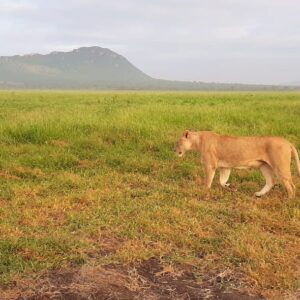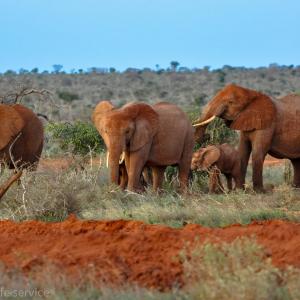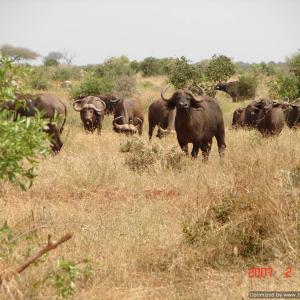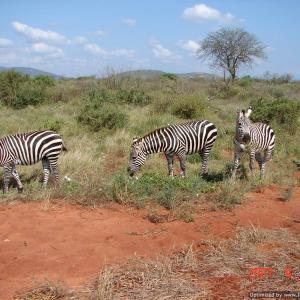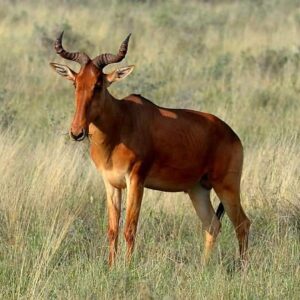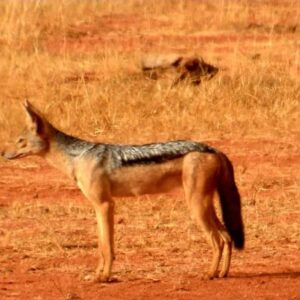“Land of Lava, Springs, Man-Eaters & Magical Sunsets”
Land of lion and lava
The joint mass of Tsavo East and Tsavo West National Parks forms one of the largest national parks in the world and covers a massive 4% of Kenya’s total land area. Tsavo West, equidistant between Nairobi and Mombasa, is painted on a sprawling canvas of endless skies, emerald hills, liquid lava flows, palm-fringed rivers, teeming wildlife and sparkling oases, set against the unforgettable backdrop of mile upon mile of cloud-shadowed African savannah.
Fact File
Altitude: 180-1,000 metres above sea level.
Area: 7,065 sq. km.
Location: South-west Kenya, inland from the coast.
Distance from Nairobi: 232 km (Mtito Andei Gate).
Gazetted: 1948
Vegetation: The Park features over 1000 plant species and a mixed habitat of bush, grasslands and acacia woodlands dotted with baobab, ivory palm, saltbush, doum palm, tamarind and fig trees.
Climate: The Park has a typical savannah climate.
Fauna: Includes: lion, leopard, cheetah, buffalo, giraffe, rhino, elephant, hippo, baboon, waterbuck, Coke’s hartebeest, gerenuk, gazelle, zebra, crocodile, mongoose, hyrax, dik dik, porcupine, lesser kudu and oryx.
Birds: The prolific bird life features 600 recorded species.
Roads: The roads are well graded, maintained and signposted.
When to go: The Park is open all year round.
Visitor Centre: A retail centre, wildlife display, visitor information centre and picnic area is situated by the main, Mtito Andei, gate
Tsavo, what’s in a name?
The Park acquired its name ‘Tsavo’, meaning ‘slaughter’ from the Akamba people, who first migrated to the area some five centuries ago.
Wonderful wildlife
Kenya’s largest National Park supports all the members of the ‘Big Five’ as well as the country’s largest elephant population. Mzima Springs is home to abundant Nile crocodile and hippo and a popular drinking spot for elephant, zebra and gazelle whilst blue and vervet monkey cavort in the surrounding acacia trees. Other mammals include buffalo, hartebeest, lesser kudu, eland, waterbuck, Grant’s gazelle, impala and giraffe. Steinbuck, Kirk’s dik dik and klipspringer are also common.
Man-eaters and mane-less lion
Tsavo achieved notoriety in the 1900’s when ‘the Man-eaters of Tsavo’, a pair of rogue man-eating lions, preyed gruesomely on the builders of the Uganda Railway. Today the Park is more famous for the numerous prides of mane-less lion that patrol the plains and police the herbivore herds.
Beautiful birds
Highlights of the birdlife include those of the semi-arid zone, such as ostrich and golden pipit while perhaps the most conspicuous are the white-headed buffalo weaver and the brilliantly plumaged golden-breasted starling. Raucous hornbill are also prevalent as are such hole-nesting birds as parrot, barbet and roller. The Park is also famous for its Palaearctic migratory bird-banding project at Ngulia Lodge.
Glorious game drives
Tsavo offers some of the most magnificent game viewing in the world – vast herds of dust-red elephant, fat pods of hippo, giant crocodile, teeming herds of plains game, a fantasia of bird life and some magical flora.
The magic of Mzima Springs
The lush, hippo-inhabited pools of Mzima Springs, fed daily by 250 million litres of water gushing from the lava flows of the Chyulu hills, provide an oasis of green, an under-water hippo-viewing chamber, two nature trails and some unique picnic spots.
Exploring the Shetani caves and lava flows
The volcanic convulsions of Tsavo’s landscape are riddled with lava flows, the most spectacular being the Shetani flow, a coalesced tide of tar-like lava that spewed down the Chyulu Hills as they burst out of the plains only a few hundred years ago. Shetani means ‘devil’ in Swahili and refers to the time, relatively recently, when the molten lava erupted from the bowels of the earth and engulfed the area. So terrifying was this event to the local people that they believed it to be the devil incarnate and tales are still rife of fire, hails of brimstone and evil spirits. The lava flow is also riddled by a series of caves, many of which can be explored, though caution is recommended.
The Ngulia Hills
30 km from Mzima Springs, along a well-marked track, is the Ngulia escarpment, (upon which stands Ngulia Lodge). Behind it rear the jagged peaks of the Ngulia Hills, a range of sheer cliffs that rise out of the plains, 610m below, to a height of 1825 m above sea level. Not only do the Ngulia hills offer magnificent vistas over the volcanic shoals of Tsavo but also, every year between late September and November, the adjacent Ngulia Bird-ringing Station plays host to one of the greatest avian spectacles in the world.
The Ngulia Rhino sanctuary
In the 1960’s Tsavo had the largest population of black rhinos in Africa (between 6,000 and 9,000) and they were a common sighted within the park. By 1981, however, Tsavo’s rhino had been poached to the brink of extinction and only 100 animals remained. Today most of Tsavo’s surviving rhino, plus numbers of re-located animals have been moved to the Ngulia Rhino Sanctuary, close to the Ngulia Lodge where a meter-high electric fence surrounds an area of 70 sq km now designated an official sanctuary for approximately 40 rhinos. The Sanctuary also offers shelter to a broad range of other threatened wildlife to include cheetah and leopard and the rare frog (Afrixalus pygmaeus septentrionalis), which occurs only in the area between Mtito Andei and Voi. The Ngulia Rhino Sanctuary is open 4pm to 6pm daily, entry free.
Climbing and trekking in the Ngulia Hills
There are some good technical climbing routes around the Ngulia Hills, the most popular of which is Kichwa Tembo (the elephant’s head). Some rewarding trekking can also be arranged.
Note: Permission to climb, walk or trek within the park is required from the Warden and you will also require the escort of a KWS ranger.
Take your pick of the picnic sites
Tsavo abounds in panoramic picnic spots, many of which offer seating areas, thatched-roof shade and small nature trails. Choose from:
Mzima Springs
A sparkling oasis offering a number of picnic areas, a nature trail, parking area and washrooms.
Poachers Lookout
A thatch-roofed lookout high on a hill with 360-degree views.
Chaimu Crater
Chaimu Crater offers a spacious parking area and an exciting scramble up this volcanic cinder cone to the crater’s rim.
Roaring Rocks
Roaring Rocks offer a parking area and a winding nature trail leading to the top of this lofty outcrop of craggy volcanic rocks where the raptors glide past at eye level. There are two view points offering magnificent vistas to the east and west of the Park and two picnic sites equipped with both shade and seating. Not surprisingly Roaring Rocks is a popular wedding venue.
Around and about
The Park is ideally situated for visits to the massive expanses of sister park, Tsavo East whilst the verdant Taita Hills and the volcanic eruptions of the Chyulu Hills are close by. World-renowned Amboseli National Park is also within easy reach.
| Economy | Ngulia Safari Lodge, Rhino Valley |
| Comfort | Ziwani Tented Camp, |
| Luxury | Kilaguni Serena Lodge, Severin Safari Camp, Finch Hattons |
